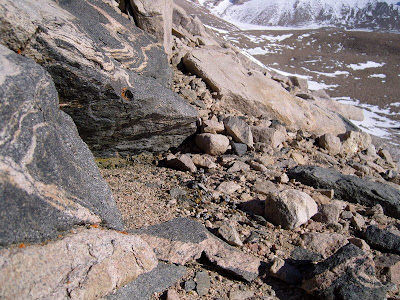
I'm about 4 km from Troll, looking back towards the station from within a lowlying moraine field. It's a partially overcast day, relatively warm at -6 degrees, but it feels colder because of the wind. Walking amongst these boulders for half an hour, there's no sign of what I'm looking for. I've chosen this site because the northwest-facing location gives maximum exposure to sunlight, hence more heat, more snowmelt and humidity, and more chance of finding life.
Even still - the rocks, the patches of sand between them, the gravel, the small shelters underneath the bigger rocks, the small meltponds forming there - all seem lifeless.

I decide to try try for slightly higher ground, and head towards the moraine-covered slope below the small glacier cap. As I approach the hillside, the winds drop, and there's less snow cover.
Happy with this decision, I start searching for the largest boulders, because bigger boulders means more stability, and more stability means sufficient time for lichen to grow and establish itself.

Finally - a small patch of lichen of
just the right type - leafy, black, and crumbly - an "epilithic foliose lichen". To speciate it properly, someone with more than a hobby-based interest in biology would have to examine it under microscope.

Even still (I enjoy guessing) - I think this lichen might be called
Umbilicaria decussata. It's not restricted to the Antarctic - cousins of this lichen actually grow back in Norway, and can be used as emergency food if you just happen to be stranded on a barren island or mountain without provisions, and are feeling desperate, adventurous, or both.

In any case, lichen tasting is not what I've come for, either, but the small patch of lichen means I'm at least in the right
microhabitat now.
I start turning rocks over, inspecting their undersides carefully with my hand lens, small brush and vial of ethanol at the ready. First rock: nothing. Second: is that something moving? Yes - along a small crack in the rock, a tiny creature, red legs and black body, barely half a millimetre across, walking sluggishly along, it's world suddenly (and literally) turned upside down. With shaking hands I scrape it up with the brush, and condemn it to quick death by alcohol. Success!
This is what I've come for - in this case I've found a tiny mite, but actually anything small that moves would be interesting. After collecting two vials of 10 mites each, I head back to station and put one under the microscope.

Most probably this is mite is called
Eupodes angardi. It's one of 10 or so species of mites in all of Dronning Maud Land. In addition there are 2 species of springtails, another group of terrestrial microarthropods.
So - have I gone crazy in my search for life in an apparently lifeless place? Regulations about wildlife collection tossed out the window, just to satisfy my own overgrown curiosity?

Actually, I'm allowed.
This mite is going to the University of Stellenbosch in South Africa, for closer examination and DNA analysis. Through a happy mix of coincidence and me not being able to keep my mouth shut, I've managed to recruit myself as assistant microarthropod collector on behalf of Jen Lee, a South African biologist who has been sampling mites and springtails around SANAE station this summer.
Her project is part of a big International Polar Year research project called "Aliens in Antarctica". The project wants to assess the risks to Antarctic biodiversity with increasing human traffic around the continent.
The mite above is not an alien, but a resident mite carefully adapted to the freezing environment, living off the sparse detritus from the black lichen. But, theoretically, mites could get transported between nunataks on the clothes and shoes of researchers or adventure tourists, and both inter-nunatak and intra-species biodiversity could be at risk.
Before someone goes out and examines these fragile ecosystems, by physically sampling these tiny animals from different locations, and by genetic analysis calculates their relatedness, we don't know much about this risk at all.
I'll be on the search for mites and springtails in the areas around Troll up until leaving (running out of time!).
Nothing better than having a good, even scientitic, excuse for goofing around with my magnifying glass.






































